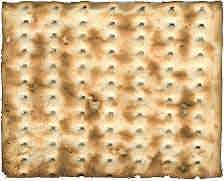The afikomen is the unleavened bread that is the desert part of the Passover supper (Seder). Let us look more closely at the afikomen and how it represented Christ.
1. It was unleavened.
Leaven represents sin (Matthew 16:6, 11-12). Christ was sinless, therefore, Christ was unleavened.
2. The Seder ends with the eating of the afikomen that the father wrapped in linen, hid or buried beneath a cushion at the beginning of the meal. A game was developed where the children would try and steal the afikomen. The father would guard the afikomen closely so it would not be stolen. [The Jewish Festivals
Jesus was wrapped in linen, buried, and his tomb was guarded so his body would not be stolen.
3. "[The] Moroccan Jews carry away with them from the Seder a piece of the afikomen, the matsoh saved for the end of the meal. They carry it as a safeguard on ocean voyages and throw it into the waters in time of storm, claiming that it has powers to calm the sea." [The Jewish Festivals
4. Some European Jews believed that the afikomen could heal the sick. [Christ in the Passover
5. In baking matzah (the bread where the afikomen comes from), the Jews would poke holes in it (so the heat will bake both sides of the bread more evenly) and place it on a grill (this resulted in the brown stripes on the bread as seen in the picture below).

Jesus was striped and pierced.
Good Books and Resources on this topic:
Home Page